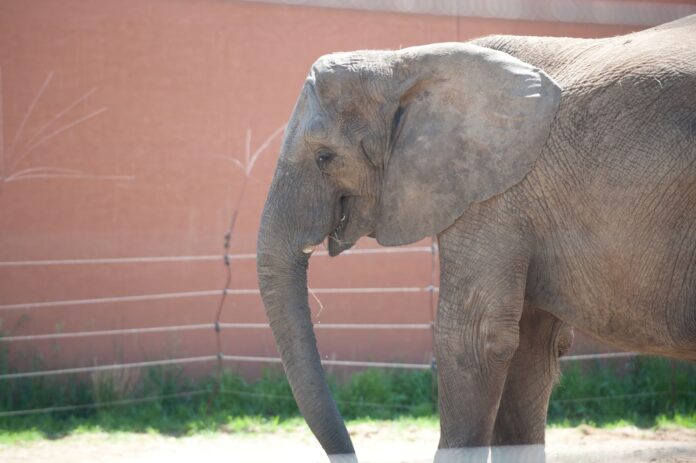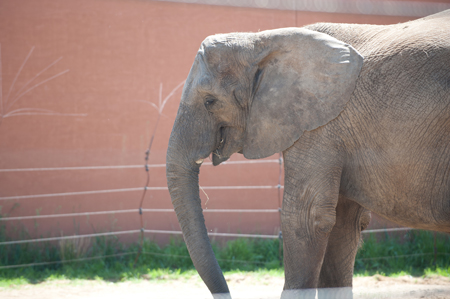
Nine-year-old Louie picks on his little brother like many siblings do — by flinging dirt at him.
But unlike his human counterparts, who squirm and stretch to bend their bodies over the exhibit’s railing to watch him, Louie can wield a trunkful.
Perhaps in a few years Louie’s kid brother Lucas will fend off flying mud cakes, but the little guy has yet to even mark his first birthday. He’ll celebrate turning 1 year old June 3, a day made all the more exciting because of his family’s new home.
The Toledo Zoo’s elephant exhibit was set to open May 18. The Tembo Trail, which replaces the old African Savanna walkway, hugs the edges of the elephants’ enclosure. Zoo-goers can catch glimpses from three of the four sides of the mock-African environment.
Zoo officials began planning to move the elephants to a larger, more enriching area in 2007. $6.2 million and more than 175 workers later, phase one opened in 2009. Crews began constructing phase two in the spring of 2010. This second portion took $9 million and 145 employees to finish.
The exhibit spreads across 37,680 square feet outdoors, pockmarked with uneven terrain and tree stumps and dotted with towering metal trees supporting leafy green canopies and dangling tires or sacks stuffed with hay.
If the elephants tire of the elements, they can choose to go indoors, where they have about 8,970 more square feet of space. During nice weather the glass windows of the indoor exhibit open like garage doors. At the old exhibit, zookeepers had to let them in or out.
“The reason that we care for animals at the zoo is that we need people to care about elephants and all other animals in the wild,” said Anne Baker, the zoo’s director. “Their habitat is disappearing and eventually it will disappear if nothing is done.”
Growing population
About 450,000-700,000 African elephants live in the wild, down from a few million at the turn of the 20th century, according to Defenders of Wildlife, a wildlife protection advocacy organization.
Toledo’s elephant population is growing. A couple of years ago, the zoo had only Renee, a 7,900-pound female, and Louie, her 4,690-pound son. In February of 2010, Twiggy joined in — brought to her new shelter after the U.S. Department of Agriculture confiscated her from poor conditions at a circus in Indiana. Although suspicious of others at first, the 27-year-old has become best buddies with Louie.
They stand side-by-side, drape their trunks over one another and take food from each other’s mouths. Baker said it is possible the two could mate, bringing the total number of elephants to five.
The zoo started its breeding program in the 1990s, and zoo officials knew then that they’d need to build a more expansive exhibit if the herd were to grow, said Andi Norman, the zoo’s public relations and marketing director.
The former exhibit was built 25 years ago and was intended for female elephants. Male elephants, as they grow into maturity, tend to fight each other for breeding access to the females. This can get chaotic and an exhibit primarily designed for females doesn’t provide the space and the strength needed to separate aggressive males from each other during this stage, Norman said.
Female elephants get aggressive, particularly when it’s time to push a young male from their circle, so the zoo had to draft plans for a new exhibit.
The Toledo Zoo is one of at least seven zoos across the country that have expanded or enhanced their elephant exhibits within the past two years, said Steve Feldman, spokesman for the Association of Zoos and Aquariums (AZA).
“The trend is that you see zoos elevating their game when it comes to the care and conservation of elephants,” Feldman said.
The emphasis is on “enrichment” — or activities that challenge elephants to problem solve to find food, along with terrain that exercises their physique, he said.
You’ll see this at the Toledo Zoo. Twiggy elicited a round of giggles May 16 when she poked her trunk through one of the holes in the exhibit wall facing her audience. She was searching for water, and she found it. The water could have been behind any of the other holes and the zookeepers switch it up to keep her and Louie guessing.
The tall metal trees are another aspect of enrichment. The tires and sacks filled with hay hang above an elephant’s eye level so the elephants have to reach for their snacks. Louie and Twiggy rolled a tree stump beneath one of the sacks so they could step on it to reach more easily, Norman said.
“Unlike people, who want our meals served on a platter, elephants spend most of their time in the wild foraging for food and water,” she said.
Elephant advocates
But some animal activists aren’t convinced. Catherine Doyle, the elephant campaign director for In Defense of Animals, said her organization advocates for zoos to close their elephant exhibits and send them to sanctuaries that offer dozens of acres to roam.
She tours zoos across the country and has legally advocated for elephants’ rights.
“You have all these artificial means of stimulating them, and these are highly intelligent animals so you have to do enrichment, otherwise these animals have nothing,” she said. “When enrichment is being done, I think unfortunately a lot of it is just something to take up the animal’s time.”
She said moving all the zoos’ elephants to sanctuaries is unrealistic, so the elephant campaign also pushes for AZA to tighten its standards on space. AZA accreditation standards recommend allotting no less than 5,400 square feet per elephant in an outdoor habitat. For indoors, the recommendation is no less than 400 square feet for females and 600 square feet for males or females with calves.
Between indoor and outdoor areas, the Toledo Zoo’s exhibit covers 46,650 square feet. The old exhibit covered 12,510.
“The public is so used to seeing elephants in smaller size exhibits, when there’s a minor expansion people think the elephants are in these huge exhibits now so everything is OK,” Doyle said. “To us it may look like a larger space but to elephants it may not.”
At least 22 zoos in the U.S. and Canada have closed their elephant exhibits since the 1990s, she said.
The Detroit Zoo sent its two Asian elephants to sanctuaries in 2005. The zoo will not open another elephant exhibit again, said Patricia Mills Janeway, spokesperson for the Detroit Zoo.
Providing the adequate physical and social environment had become unrealistic, particularly because of Michigan’s harsh winters. The two elephants had arthritis and foot problems, health issues common among captive elephants. Living in small areas or standing on concrete floors are believed to trigger these health problems, Janeway wrote in an email to Toledo Free Press.
“In the wild, elephants live in warm climates and roam vast areas, often walking many miles a day,” she wrote. “For these reasons, the Detroit Zoo decided in 2004 to no longer exhibit elephants.”
Doing well in winter
The African elephants at the Toledo Zoo do well in the winter, said Ben Whitebread, interim elephant manager. The elephants can go outside overnight if it’s no colder than 32 degrees. They also have a heated porch between their indoor shelter and the outdoor area, so they don’t have to spend all of their time inside during the winter months, he said.
He said he’s watched the elephants go outside during 25-degree days and amuse themselves by breaking the ice frozen over puddles.
“A lot of people feel that because these elephants are from Africa, that they can’t tolerate cold and that’s very far from the truth,” Whitebread said.
Baker said overheating is more of a problem for these animals because of their size.
“It’s hard for them to dump heat — the nights in Africa get very cold, so they warm up in the day and over the night they cool down,” she said.
Whether Twiggy, Louie, Renee and Lucas are inside or out, zoo-goers will be able to get a close look at these colossal mammals this summer, Norman said.
Tembo Trail opening weekend ceremonies
The Grand Opening for the Tembo Trail will kick off May 18 with a ceremony at 10:15 a.m. at the trail entrance.
Drums of Thunder will perform at 10:30 a.m., followed by a performance by I AM ART, with singing, dance, African drums and storytelling at 11 a.m. at the trail entrance.
Staff will host educational activities at the entrance from 11 a.m. to 2 p.m.
Otter keepers will talk at 1:15 p.m., followed by an elephant training demonstration at 2 p.m.
May 19 will be full of arts and entertainment from 11 a.m. to 3:30 p.m., including a performance by the Toledo School for the Arts Glass City Steel band.
The zoo will host events on May 20 as well, with African-themed education activities and crafts and more performances by the Glass City Steel.
Walk the Tembo Trail and see naked mole rats, African spotted-neck otters, African lions, African slender-snouted crocodiles, dromedary camels, meerkats, Nile hippopotami and white rhinoceroses.
























